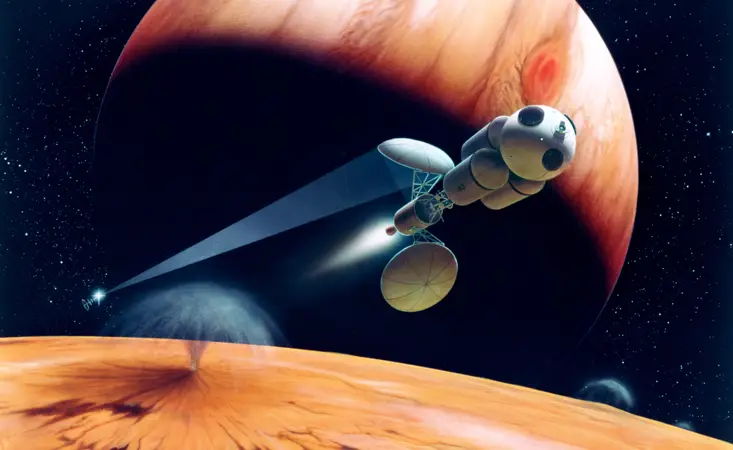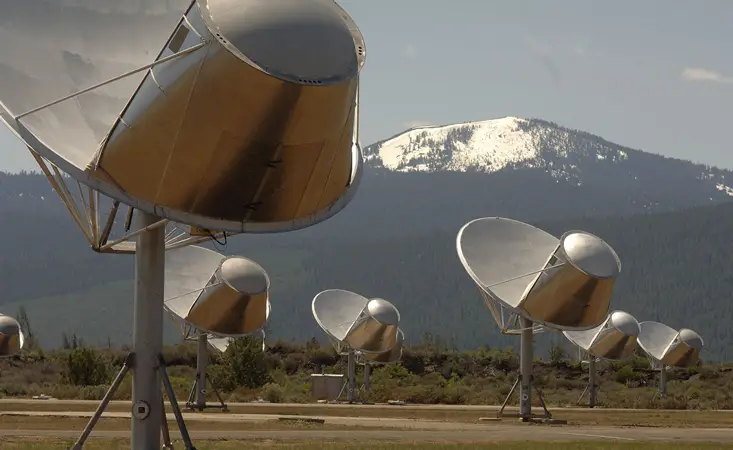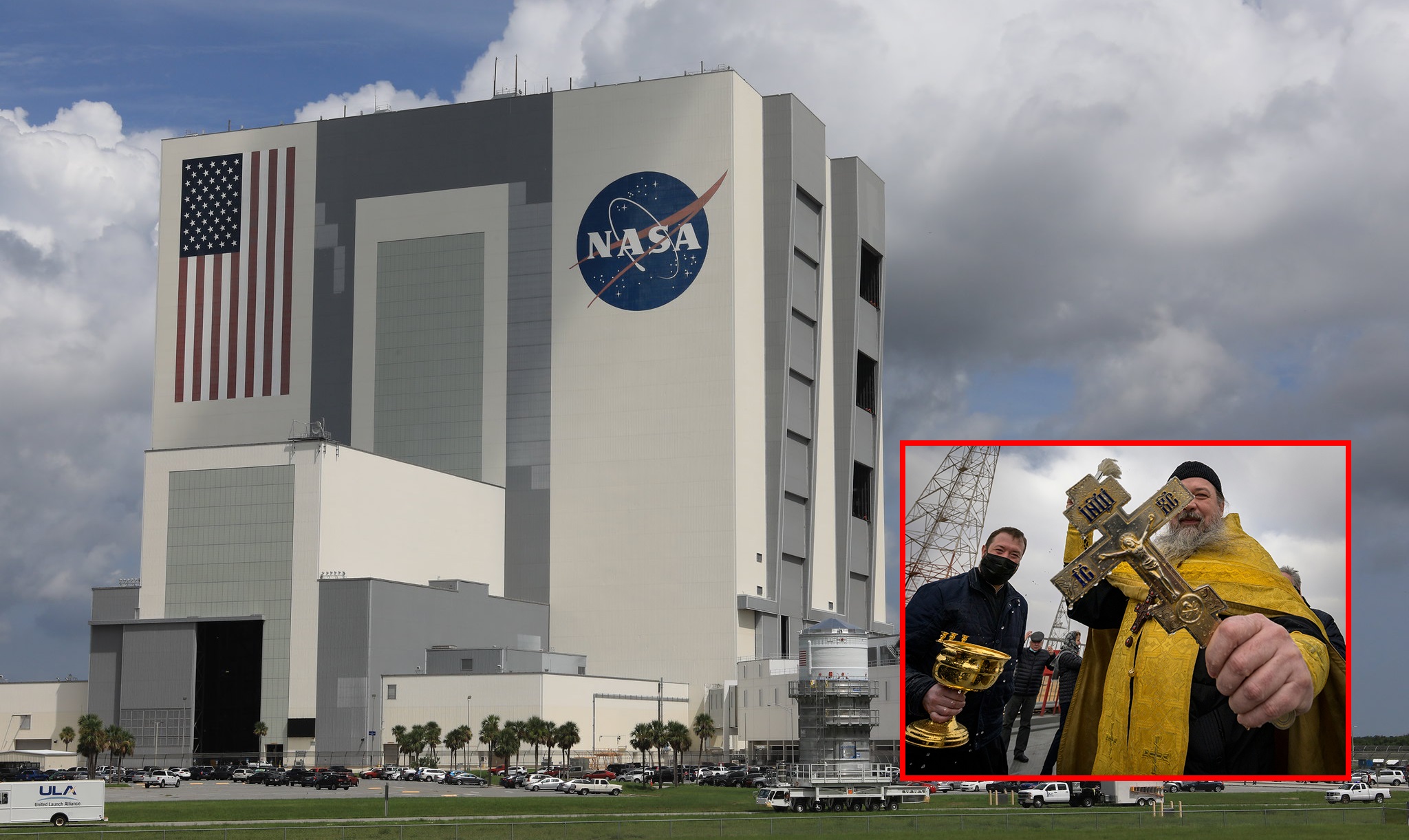The majority of Christians in the United States think there is no possibility of life on other planets. They maintain that the Bible precludes such a possibility. However, eminent theologians take a contrary position. In 2008, the Vatican’s senior astronomer said that there is no contradiction between faith in God and the possibility of alien life.
The organization recruited 24 theologians to participate in a program at Princeton University’s Center for Theological Inquiry (CTI). Their mission was to determine how humans might behave if extraterrestrial life was discovered in other worlds. They intended to learn, in particular, how such a finding may affect people’s conceptions of gods and creation.
The Rev Dr. Andrew Davison, a priest, and theologian at the University of Cambridge were one of the theologians. The Oxford-educated monk possesses a degree in biochemistry. Rev Dr. Davison commented in a blog post at the University of Cambridge, “Religious traditions would be a critical component of how humankind would deal with any such confirmation of life beyond.”

Davison is also planning to write a book on the topic for publication in 2022. The title of the book, Astrobiology and Christian Doctrine, indicates that the world is growing closer to discovering alien life. Davison also notes in the book that “adherents of a variety of religious systems claim that they are able to accept the concept.”
Other academic ‘believers’ concur that the prospect of finding life in other worlds exists. According to Duilia de Mello, an astronomer and physics professor at Catholic University, “If we are the products of creation, why is it that life cannot evolve on other planets? There is no evidence to the contrary.”
Nonetheless, there remains disagreement on the subject. In a 2008 interview, Albert Mohler, president of Southern Baptist Theological Seminary, said that there is no prospect of life in other worlds. While acknowledging that Scripture does not rule out the possibility of life elsewhere in the world, Mohler emphasized that “what we are informed is that the cosmos was created in order for Jesus Christ to come to rescue sinful humanity on this planet, in space and time and history.”
The future will reveal. The James Webb Telescope, dubbed a time machine capable of revealing the universe’s earliest secrets, is on its way to exploring space. It will be used to study some of the very earliest galaxies to form almost 13.5 billion years ago.
Alien contact could be ‘extremely dangerous’
Furthermore, physicist and Washington Post writer Mark Buchanan warned earlier this year that making contact with aliens might be “very harmful” and could even “end the life on Earth,” according to his essay. Note that experts from all across the globe have not ruled out the possibility of life beyond our solar system.
Several alien abduction stories have appeared on the internet, according to a study by the International Business Times. Most of them seem to be staged hoaxes. But there are still a few compelling mysteries that have yet to be solved. MUFON researcher Chris Jones has indicated that extraterrestrial abduction tales recorded by individuals from throughout the globe may be accurate.
If Aliens Exist Here’s Where We’ll Find Them to The Year in Physics (Planet Earth Report)
Assume there are intelligent lifeforms out there, and that some of them have been keeping an eye on our planet for the last four and a half billion years. We do not know what they were looking at. Earth’s appearance changed gradually and subtly during most of that long period of time. Many species were extinct when continents drifted apart; the ice cover on the oceans grew and waned, and new species appeared and developed.
However, throughout the past hundred years, the patterns of vegetation changed far more rapidly than they had in the previous millennia. This was the beginning of agriculture and the rise of cities. Population growth led to more rapid changes.
After then, things changed even quicker. Carbon dioxide levels in the atmosphere started to climb at an alarming rate within a century. Rockets fired from the surface of the planet fled the planet’s biosphere entirely, a phenomenon that was previously unheard of. In addition to orbiting the Earth, several spacecraft traveled to the moon, Mars, Jupiter, and even Pluto.
What might they see in the following century if those imagined extraterrestrials kept their eyes open? It is possible that climate change may lead to a last burst of activity, which will then be followed by quiet. Or will the ecosystem of the world be able to stabilize itself? The question is, will the planet be dramatically altered? No one knows for sure what will happen when an armada of spacecraft is launched from Earth.
Let us look at the future of space exploration in particular. Last-century technology was used to conduct successful missions such as Viking (Cassini), New Horizons (Juno), and Rosetta (Rosetta). The whole solar system, including the planets, moons, and asteroids, will likely be explored by robotic devices in the next century.
For crewed spacecraft, what is the future of humans?
Perseverance Rover, NASA’s latest Mars rover, may miss out on some fascinating findings that no human geologist could have missed. Machine learning and sensor technology, on the other hand, are both rapidly progressing. Despite this, the cost disparity between crewed and autonomous missions is still enormous.
With private companies like SpaceX and Blue Origin, we think the future of crewed spaceflight is in the hands of private explorers willing to take on a riskier program than western governments could impose on publicly backed enterprises. Even though NASA and the European Space Agency have made significant advances in rocketry, these companies have developed and improved rocketry significantly more quickly than NASA or the European Space Agency. In the future, national agencies will play a smaller function, more analogous to a terminal than a plane terminal.
Darwinian evolution is drawing to a close, but the emergence of sentient life on Earth as a technological species is only getting started.

We believe that missions involving people should be fronted by private firms with charismatic leadership as low-cost, high-risk endeavors. In the same manner that early explorers and mountaineers were motivated by the same reasons, there would still be a large number of volunteers willing to take one-way tickets and join the effort. Space tourism should be avoided at all costs. These kinds of endeavors seem to be ordinary and low-risk to the general public. If that is the case, then the inevitable mishaps will be just as horrific as the shuttle disasters were for the people on board. These undertakings must be marketed as risky, extreme sports or intrepid exploration in order to be commercially viable.
Chemical fuel’s inherent inefficiency and the necessity to carry a weight much above that of the payload are the most significant obstacles to space travel. The interplanetary flight will remain difficult as long as we are reliant on chemical fuels. Nuclear power has the potential to be a game-changer. Astronauts’ exposure to radiation would be greatly reduced if they were allowed to travel at significantly greater in-course speeds through the solar system. With a “space elevator” pushing spacecraft into orbit and then utilizing a “star-shot”-type laser beam to push on a “sail,” it is more economical to have the fuel supply on the ground.
Thrill-seekers like Felix Baumgartner (the Austrian skydiver who broke the sound barrier in free fall from a high-altitude balloon in 2012) may have based on Mars or asteroids by 2100 if predictions hold true. However, Elon Musk has said that he would prefer not to perish on collision with Mars. It is a doable objective, and it appeals to certain people.
Although widespread exodus from Earth is not expected, Believing that outer space is a safe haven from Earth’s woes is a hazardous illusion. This is something we must address. The COVID-19 pandemic or coping with climate change may sound intimidating, but terraforming Mars is a piece of cake. If you could find a spot like Antarctica or Mount Everest’s summit in our solar system, you would be hard-pressed to find one. To put it simply, there is no “Planet B” for those who are afraid of taking risks.
Even Nevertheless, we on Earth (and our future generations) should show our support for these daring astronauts. As the future of humanity progresses, they will be essential in shaping the next century and beyond.
Because they will be unable to adjust to their new environment, the first explorers will have a strong desire to redesign themselves. Genetic and cyborg technology that will be created in the next several decades will be used to their full potential. This might be the beginning of a new species’ evolution.
The emergence and evolution of life on a planet’s surface are necessitated by an organic environment. The absence of an atmosphere will not be a problem for post-humans who succeed in becoming entirely inorganic intelligent beings. As a matter of fact, some may even enjoy working in zero gravity. Deep space may be the place where non-biological minds might acquire capacities that we can not even begin to comprehend.
Organic brains can only grow to a certain size and processing capability due to chemical and metabolic constraints. It is possible that we have already crossed these boundaries. Electronic computers, on the other hand, have no such restrictions or limitations (still less, perhaps, quantum computers). As a result, under any definition of “thinking,” biological human-type brains will be overwhelmed by the cerebrations of artificial intelligence.
While Darwinian evolution may be nearing its conclusion, sentient humans are just starting to evolve technologically. There is a possibility that it will occur most quickly away from Earth; we do not anticipate (and surely do not desire for) such rapid changes in humans on Earth, but our existence may be contingent on the AI on Earth being “benevolent.”
There is no doubt that robots will eventually overtake or augment many of our uniquely human skills. Disagreements arise solely on the timing of this event. Ray Kurzweil, an inventor, and futurist, predicts that it will happen within a few decades. Scientists who are more cautious estimate centuries. In any case, technological advancements occur in a fraction of the time it took for evolution to lead to the creation of humans, and even less than a millionth of the vast expanses of cosmic time that lie ahead. As we have exceeded slime mold, future technology advancements may outpace us.
Nonetheless, you may think, “What about the mind?”
Physicists and philosophers disagree on whether awareness is unique to the moist, biological brains of humans, apes, and dogs. Would it be possible for electronic intelligence, despite its apparent superhuman brilliance, to be devoid of self-awareness? Imagining things that are not there? Do you have a soul? It is also possible that awareness is an emergent characteristic of any sufficiently complex network. Some think it is semantically irrelevant, like asking whether submarines can swim or not.
A swarm of tiny probes might make up an extraterrestrial civilization that has gone unnoticed.
Not according to us. As “zombies,” computers would not be given the same weight as human experiences and the post-human future would seem to be grim. On the other hand, if they are aware, we should embrace the possibility of their predominance in the future.
In the event that they become completely independent creatures, what will be their primary motivation? We are forced to accept that we have no understanding of what is going on. There has been a wide range of odd motivations for human achievements in the past, including ideologies, financial gain, political gain, egotism, and religion. When it comes to our naïve assumptions, here is a basic example: Alternatively, they may have been thoughtful in their thoughts.
It is possible they may find it is easier to think of low temperatures, so they will migrate far from any star or perhaps go into hibernation for billions of years until the cosmic microwave background temperature drops much below its present 3 degrees Kelvin. This would be much less noticeable. A more extreme scenario is that civilizations will continue to grow and spread outwards, which is what most people believe will happen throughout time.

Even if life began only on Earth, it does not have to be an insignificant blip on the cosmic radar. As a starting point, humans may begin the process of spreading ever-more sophisticated intellect throughout the cosmos. It is possible that the “sphere of influence” (or “frontier of conquest,” as some see it) may extend throughout the whole galaxy, transmitted by self-replicating devices, DNA, or 3-D printer instructions. This is merely the beginning of a long journey that will take us to other galaxies. Near-immortals would be unafraid of interstellar or perhaps interplanetary travel.
This galaxy colonization would take less time than the more than 500 million years since the Cambrian explosion, even if just presently known propellants were utilized. As a matter of fact, it is been less than 55 million years since the emergence of primates.
We would become so noticeable to any other civilization that the expansionist scenarios have as a result that we would be discovered.

Are there any other expansionists whose realm may intrude on ours?
What we do not know In order for intelligence to develop, it may need a very unusual series of events and occurrences, such as winning a lottery. Enrico Fermi, a scientist, voiced his amazement at the lack of evidence for intelligent life in the Milky Way, and this will disappoint SETI searchers and explain the so-called Fermi paradox. But what if we are not the only ones? What kind of proof would we look for?
Perhaps other planets have evolved in a similar fashion to Earth’s, and we will never know for sure until we find out. But even then, it is exceedingly rare that the most important phases would occur at the same time. If the development of intellect and technology on a planet is much slower than on Earth (for example, because the planet is younger or because certain evolutionary bottlenecks have taken longer to negotiate), then that world would disclose no signs of extraterrestrial life. It is likely that Earth was not discovered as a habitable planet during the first two billion years of its existence.
Life may have had a billion-year head start orbiting a star older than the sun. Note that the solar system’s present age is nearly half the age of our galaxy and also half of the sun’s anticipated complete life expectancy. Many of the stars in our galaxy are expected to be older than the sun.
Human technological civilization has only existed for a few thousand years. Inorganic intelligence will eventually surpass or exceed human intellect, but it will continue to increase at a rate greater than Darwinian evolution for billions of years. We may not be able to capture an extraterrestrial civilization with human-level intellect while it is still incarnate in that form since it may be only a short interlude before the machines take control. When it comes to ET, it is much more plausible that the dominating animals are not made of flesh and blood—and may perhaps not be bound to a planet at all.
The Drake Equation, a probabilistic effort to estimate the number of sophisticated civilizations in the Milky Way, has been demystified by astronomical measurements. Astronomers are now able to directly estimate the total number of possibly habitable planets, which was previously unknown. Reinterpreting a critical element in the Drake equation is also necessary. Millennia at the most is the maximum lifespan of a biological civilization. For billions of years, its electronic diaspora might continue
Deep space may be the place where non-biological minds might acquire capacities that we can not even begin to comprehend.
This means that even if SETI is successful, it is very improbable that the signal will be decipherable. More than likely, it would point to a byproduct or failure of some very complicated mechanism that we are unable to comprehend.
The term “alien civilizations” may impose too many restrictions on our thinking. A civilization is defined as a group of people living together. Either way, it is possible that ET is a single entity with several minds. In the same way that an experienced radio engineer who is only acquainted with amplitude modulation (AM) transmission could have a hard time decoding current wireless communications, we may not perceive messages as artificial because we may not know how to decode them. When a signal is predictable, there is room for greater compression. That is why compression algorithms strive to reduce signals to as near to noise as feasible.
Until now, SETI has concentrated on the radio spectrum. We should, however, investigate all possible wavelength ranges, including optical and X-ray. We should also be on the lookout for signs of non-natural behavior or occurrences. Is there a signature that might be considered quite generic? One of the markers of modern civilization, energy use, seems to be difficult to hide.
Starlight is one of the most likely long-term sources of energy for modern technologies. A mega-structure is known as a “Dyson Sphere” might be built by powerful extraterrestrial civilizations to gather stellar energy from a single star, several stars, or perhaps a whole galaxy.
It is also possible to use hydrogen fusion to generate long-term power. We may expect waste heat and a mid-infrared signal in any scenario. Other possibilities include looking at large objects like the Dyson Sphere. It is worth exploring for relics in our own solar system, for some strange reason: If an extraterrestrial society had mastered nanotechnology and transmitted its intellect to machines, the “invasion” may have consisted of a swarm of tiny probes that might have escaped our detection. Even yet, sending a radio or laser communication would be faster and less expensive than trying to travel the vast distances of interstellar space.
And now for something completely different: let us fast-forward millions of times farther in time than a few millennia. A collision with the Andromeda galaxy, around 4.5 billion years from now, would jolt our galaxy’s star birth and death cycle back into action, as interstellar gas is depleted over time. The remnants of our galaxy, Andromeda, and its smaller neighbors (together referred to as the Local Group), will coalesce into a single amorphous galaxy.
Due to the increasing expansion of the universe, distant galaxies will travel further away, retreating faster and faster until they reach a horizon beyond which they are lost from observation and casual touch. However, the Local Group’s remains might survive for a much longer period of time. This is long enough for a “Kardashev Type III” phenomena to occur, in which a civilization harnesses energy from one or more galaxies and maybe even supermassive black holes, as the conclusion of the long-term tendency for living systems to acquire complexity and negative entropy (a higher degree of order).
Since protons may theoretically be transmuted into any element, and the total available energy (E=mc2) can theoretically be transmuted from one form to another, these are the only basic physics constraints.
On a cosmic scale, all the atoms that were previously in stars and gas may be converted into structures as complex as a living body or silicon chips. Star-scale engineering to produce black holes and wormholes is a scenario that some science-fiction writers envision, but it is not a violation of fundamental physical rules.
The overall mass-energy content of the Local Group is not the only resource we have at our disposal if we want to push things any farther. Even if a technologically powerful civilization were to lasso the retreating galaxies caused by the cosmic expansion of space before they speed and vanish beyond the horizon, this would still be in accordance with physical rules. Einstein’s initial concept of a static world in equilibrium, with an average density that balances the cosmic repulsion induced by dark energy, may be realized by a hyper-intelligent race.
In light of what we now know about physics principles and the cosmological model, what we have stated so far is correct. It is assumed that the repulsive force responsible for cosmic acceleration (also known as dark energy or Einstein’s cosmological constant) continues to exist in our theories of the universe. However, we must be open to the notion that there is much that we do not comprehend.
Since our ancestors roamed the African savannah and dealt with the difficulties of existence, our brains have altered remarkably little. Astonishingly, these brains have enabled us to make sense of a universe far away from the ordinary world in which we have evolved: the quantum, subatomic world.
The boundaries of science are rapidly expanding right now. But there is a chance we may run into trouble. Even a gorilla can not fathom the nature of stars and galaxies, much alone certain occurrences that may be critical to our long-term future. Physical reality may have intricacies that our brain and senses are unable to comprehend.
People with electronic minds could see things differently. As a result, we have no way of predicting or even comprehending the motivations of such minds. We can not tell from the Fermi paradox whether their absence is a hint of anything more than just a desire.

